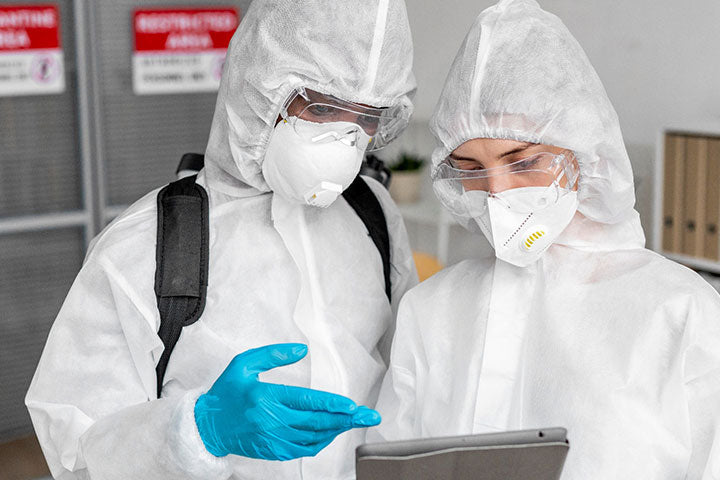The Importance of Biosafety Cabinets in Research and How to Choose the Right One
Biosafety Cabinets (BSCs) keep you and your cultures safe. They help create a sterile environment for you to work and protect you, your products, and the environment from exposure to biohazards and cross-contamination.
Here is what you need to know and consider when getting your next BSC:
Understanding Biosafety Cabinets
Biosafety cabinets are categorized into three classes: I, II, and III. Each class offers different levels of protection and is suitable for various types of research.
- Class I:
- A Class 1 BSC is similar to a fume hood.
- Air from the room you are working in is pulled through the front of the BSC and is then filtered through a HEPA filter before it leaves the BSC.
- This offers you and other things in the room safety, but cannot be used to prevent contamination of any specimens you are working with within the cabinet.
- Class II:
- This is the type of cabinet you are most likely looking for!
- A Class II BSC offers incoming and outgoing HEPA filtration.
- Incoming filtration on Class II cabinets helps prevent contamination since all air being pulled through the cabinet is filtered. Outgoing filtration makes sure the air is clean again before it reenters the room.
- Class III:
- This is for working with nasty or infectious reagents.
- Class III cabinets are completely enclosed and are typically identified with rubber gloves mounted in the front sash of the cabinet.
Why Biosafety Cabinetsare Critical
If you are reading this, you probably already know why BSCs are important. However, just incase you are wanting the cliff notes version of what they do, here you go:
- Personnel Protection: Inbound air flow helps prevent vapors from escaping the front of the sash where you are sitting when working inside the cabinet.
- Environment Protection: HEPA filtration or externally exhausting the
- Specimen Protection: Helps prevent contamination of biological samples and research materials (Remember Class II & Above Only).
Tips for Purchasing a BSC
There are quite a few brands out there. If you are looking for a higher end brand but still cost effective, something like a Baker, Nuaire or Thermo biosafety cabinet will do you well. If you are strictly looking for a budgetary option
Most modern BSC’s utilize brushless motor technology for moving air through your cabinet. These are great for both energy savings as well as eliminating brushes on the fan motor so you save on maintenance costs
Good used equipment sellers will fully test equipment. This includes both the obvious and not so obvious features. Some things that good sellers will test before selling include:
- HEPA Filter Integrity (protection for you, the environment and your specimens - class II cabinets and above)
- Blower (Makes sure the blower is working properly)
- Lights (Gives you proper lighting within the cabinet)
- UV Sterilization (Sterilizes the work surface when not in use)
- Outlets within the cabinet (so you can plug in equipment within the cabinet)
In order to fully certify a biosafety cabinet it must be already installed in the location you will be using it. This means that once you get your cabinet you will want to have a local certification company come and certify your new purchase. If you are buying locally, there is a chance your seller does certifications so you can pay for local delivery, setup, and certification so you are ready to go from the get go.
Worth Noting - Certifications
If you are handling biological materials or chemicals within your biosafety cabinet or needing to adhere to OSHA standards (pretty much all of us I expect), you will need to have your BSC certified each year. This certification should cost $200 or less per BSC and will certify that your cabinet HEPA filters are functioning correctly as well as certify that the airflow into your cabinet are within specification to help keep you and your specimens safe while working at the BSC.
Make sure that the company you choose to do your certifications actually does the full certification. Sadly, a quick certification that wasn’t fully performed saves you and the certifying technician time, however, if you want to make sure yourself, your employees, and your specimens are contaminate free - ask them to take their time and do the certification properly. In the industry we refer to the practice of speeding through certifications “Sticker Licking”, since each new certification comes with a sticker verifying the certification.
Trust us, you want it done right, especially since adjustments on your machine are required pretty regularly during the certification process to keep it within certification specification. These adjustments will be included within the price you paid for the certification.
Conclusion
Biosafety cabinets are crucial to many areas of lab research. If you need help installing, certifying, or purchasing a BioSafety Cabinet we are here to help. Check us out on our website rdlaboratoryequipment.com or give us a call/text at 619-518-3883.






